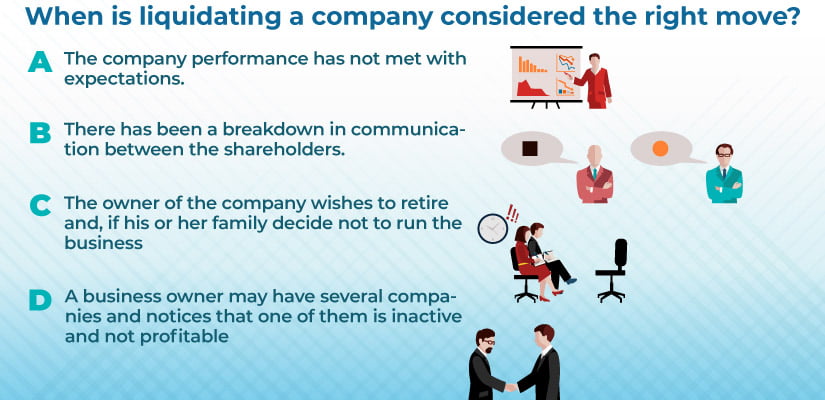
Is your company not functioning or has it become dormant? Perhaps you are considering winding up your company in Spain and do not know the steps that need to be taken. In this post we explain what needs to be done to dissolve, close or liquidate a company in Spain.
The differences between dissolving, closing and liquidation a company in Spain
There are different ways in which a company can be restructured; this can lead to confusion between business liquidation, dissolution and closure. Here are some of the differences:
- Dissolution: This where a company is extinguished and undertakes an irrevocable voluntary strike-off.
- Liquidation. This is one of the phases of dissolution and can take part at the same time or after the company strike off. It leads to the distribution of equity between shareholders, once all credits have been settled and debts paid.
- When a company ceases to be active but can begin to trade again in the future.
What does it mean to liquidate a company?
The liquidation of a company means that your company or business is formally closed down and extinguished. By liquidating a company all the debts with third parties are settled, credits are paid by those who owe you and, finally, any leftover equity is distributed between shareholders.
In order to liquidate a company, the following processes are usually required:
- The company will go through a credit collection process to receive all pending payments
- The company will pay all outstanding debts.
- The company will sell all stocks and shares which it holds, to convert them into cash.
- Finally, liquidation can take place to extinguish the company.
Once the above processes have taken place, the shareholders should hold a general shareholders meeting to agree or approve the dissolution of the company and thus its liquidation. The agreement should consider the following matters:
- The liquidation quota to distribute among the shareholders (respective liquidation quotas are distributed in line with share capital in the company)
- The stepping down of company directors and the appointment of liquidators.
- The approval of the liquidation balance sheet.
Once the minutes have been drawn up and the main points have been approved, the liquidator must issue and sign a Certificate of the Shareholders’ Meeting Minutes.
Furthermore, the liquidator must appear before a Notary Public and sign a winding-up deed for the company. Once this public deed has been issued, stamp duty must be paid to the corresponding tax office of the local area (electronic payments are now accepted with a digital signature) and a tax of 1 % of the settlement amount being shared among shareholders.
Subsequently, you should place a deposit and register this step with the corresponding Mercantile Registry, filing the public winding-up deed before a registrar who will enter it into the Register.
When the public deed has been entered into the Mercantile Registry, the Spanish tax authorities need to be informed that the company has been wound up, as do the Social Security authorities for employment purposes.
When is liquidating a company considered the right move?
There are several situations in which a company owner may decide to liquidate a company. These include:
- The company performance has not met with expectations, it is not making money and previous quarters have closed with a loss; therefore, the owner decides to close the company.
- There has been a breakdown in communication between the shareholders, with disagreements leading to a pause in decision making and perhaps even situations of hostility. When a freeze like this occurs, it can lead to the legal dissolution of a company.
- The owner of the company wishes to retire and, if his or her family decide not to run the business and they do not find a third-party purchaser, they can decide to close the company.
- A business owner may have several companies and notices that one of them is inactive and not profitable, therefore a decision is taken to liquidate it.
Steps to take to liquidate a company
The steps to take to liquidate a company are the following:
- Draw up the liquidation balance sheet.
- Reach a shareholders’ agreement on the decision to dissolve and liquidate the company, on the settlement balance and on the distribution of the equity between the shareholders.
- The company director must issue a certificate concerning the liquidation agreement approved by the shareholders.
- The public winding-up deed must be signed before a Notary Public.
- The public winding-up deed must be filed with the Mercantile Registry.
- The company’s current account must be closed.
- The company must be formally removed from tax and social security registries.
It goes without saying that knowing what liquidating companies implies is important before deciding whether it is best to cease your activity or restructure the company. This is not an easy decision to take and in most cases it requires detailed advice from a business consultancy with expertise in these affairs who share knowledge that will help you take the most beneficial route.
Leialta website: https://www.leialta.com/en/
Blog for doing business in Spain: https://www.leialta.com/en/blog-for-doing-business-in-spain/
Linkedin: https://www.linkedin.com/company/leialta-s-l-/mycompany/

